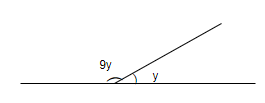
The measure of an angle which is $9$ times its supplement.
A. $162$
B. $81$
C. $90$
D. $10$
Answer
463.5k+ views
Hint: We will assume the supplement angles as $x$ and $y$. We have the relation between supplement angles as $x+y=180{}^\circ $. In the problem they have mentioned the angle $x$ is $9$ times its supplement, then we will get a relation between $x$ and $y$. From these two relations we can find the values of both $x$ and $y$.
Complete step by step answer:
Let $x$ and $y$ be the supplement angles.
We know that the sum of the supplement angles is equal to $180{}^\circ $.
$\therefore x+y=180{}^\circ ...\left( \text{i} \right)$
In the problem, we have given that the one angle is $9$ times its supplement, then we will get
$x=9y$ or $y=9x$
If $x=9y$, from equation $\left( \text{i} \right)$ the value of $y$ is given by

$\begin{align}
& x+y=180{}^\circ \\
& \Rightarrow 9y+y=180{}^\circ \\
& \Rightarrow 10y=180{}^\circ \\
\end{align}$
Dividing with $10$ on both sides of the above equation, then we will have
$\begin{align}
& \Rightarrow \dfrac{10y}{10}=\dfrac{180{}^\circ }{10} \\
& \Rightarrow y=18{}^\circ \\
\end{align}$
Now the value of $x$ is $9y=9\times 18{}^\circ =162{}^\circ $.
So, the correct answer is “Option A”.
Note: In this problem they have mentioned that the angles are supplementary. So, we have taken the sum of the angles as $180{}^\circ $. If they have mentioned that the angles are complementary, then we need to take the sum of the angles as $90{}^\circ $ and follow the same procedure to find the angles.
Complete step by step answer:
Let $x$ and $y$ be the supplement angles.
We know that the sum of the supplement angles is equal to $180{}^\circ $.
$\therefore x+y=180{}^\circ ...\left( \text{i} \right)$
In the problem, we have given that the one angle is $9$ times its supplement, then we will get
$x=9y$ or $y=9x$
If $x=9y$, from equation $\left( \text{i} \right)$ the value of $y$ is given by

$\begin{align}
& x+y=180{}^\circ \\
& \Rightarrow 9y+y=180{}^\circ \\
& \Rightarrow 10y=180{}^\circ \\
\end{align}$
Dividing with $10$ on both sides of the above equation, then we will have
$\begin{align}
& \Rightarrow \dfrac{10y}{10}=\dfrac{180{}^\circ }{10} \\
& \Rightarrow y=18{}^\circ \\
\end{align}$
Now the value of $x$ is $9y=9\times 18{}^\circ =162{}^\circ $.
So, the correct answer is “Option A”.
Note: In this problem they have mentioned that the angles are supplementary. So, we have taken the sum of the angles as $180{}^\circ $. If they have mentioned that the angles are complementary, then we need to take the sum of the angles as $90{}^\circ $ and follow the same procedure to find the angles.
Recently Updated Pages
Glucose when reduced with HI and red Phosphorus gives class 11 chemistry CBSE

The highest possible oxidation states of Uranium and class 11 chemistry CBSE

Find the value of x if the mode of the following data class 11 maths CBSE

Which of the following can be used in the Friedel Crafts class 11 chemistry CBSE

A sphere of mass 40 kg is attracted by a second sphere class 11 physics CBSE

Statement I Reactivity of aluminium decreases when class 11 chemistry CBSE

Trending doubts
Fill the blanks with the suitable prepositions 1 The class 9 english CBSE

How do you graph the function fx 4x class 9 maths CBSE

Name the states which share their boundary with Indias class 9 social science CBSE

Difference Between Plant Cell and Animal Cell

What is pollution? How many types of pollution? Define it

What is the color of ferrous sulphate crystals? How does this color change after heating? Name the products formed on strongly heating ferrous sulphate crystals. What type of chemical reaction occurs in this type of change.




